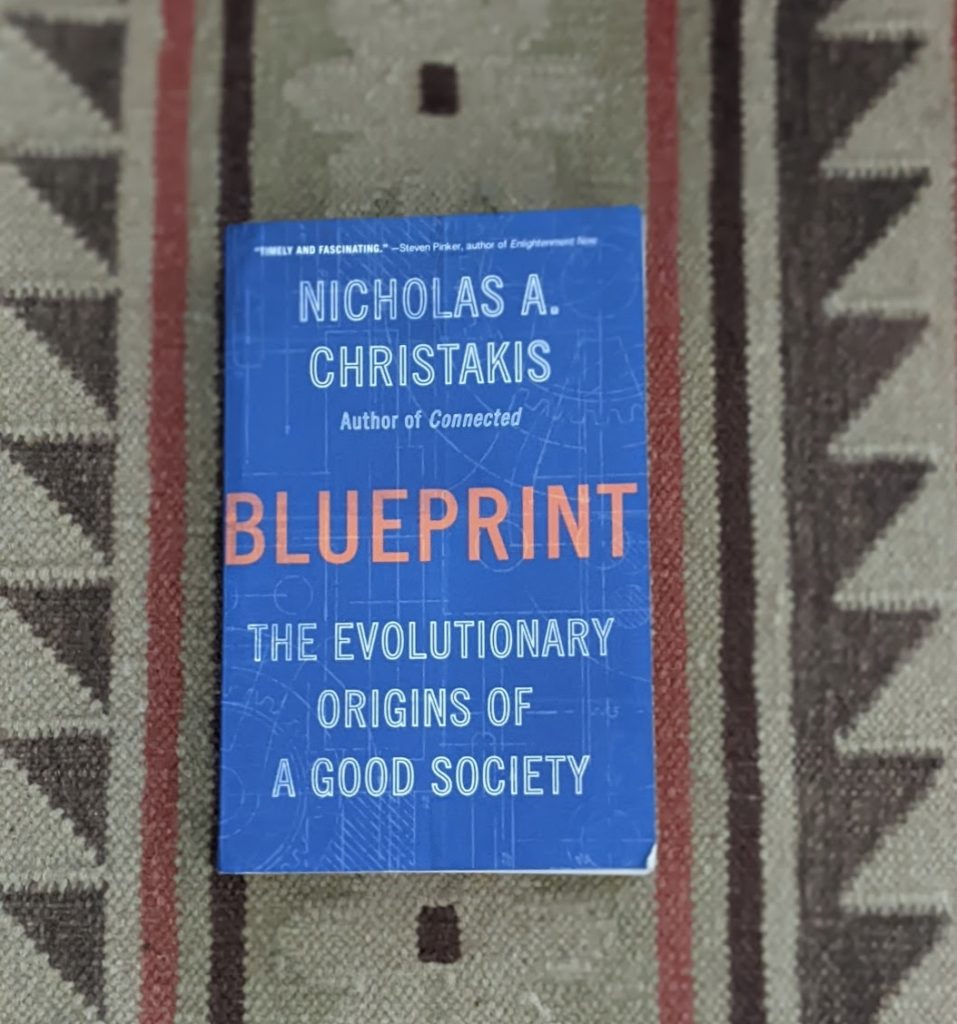Nicholas A. Christakis
I had hoped to begin the year with a book that broadens my thinking, and Blueprint most definitely does. It is in different ways related to two books that I read recently – Behave, and The Dawn of Everything. The former was about why we behave the way we do, starting from neurotransmitters and hormones right back to evolution even before we became a species. The latter was about why our linear way of seeing the evolution of humanity is inherently flawed, and how that is increasingly being proved by archaeological evidence. Blueprint is about how our genes affect not only our bodies and behaviours, but also the ways in which we make societies. It also does a fantastic job of (granularly) showing how all this is evolution at play from a time far before we became a species.
There is another way in which Blueprint resembles Behave. The first hundred pages don’t do justice to the rest of the book. While it was the complexity in the latter, in this it’s the seeming simplicity. From the preface onwards, there is a focus on balancing a couple of diverse ideas – the universality of our shared inheritance and the uniqueness of the culture we have built and the individuals we are. The objective in the early part of the book is to illustrate the “social suite” inherent in all societies – having and recognising individual identity, love for partners and offspring, friendship, social networks, cooperation, preference for one’s own group (in-group bias), (only) mild hierarchy, and social learning and teaching. So irrespective of the origins of any particular society, it follows a blueprint that evolution has provided. There are examples in intentional, unintentional (say, shipwrecks) and artificial (experiments). Having said that, one should also be conscious of context emergence – the collective having a set of properties that might be different from the components. (an excellent example is carbon atoms creating both graphite and diamonds). An interesting point on the environment humans face – the one thing that does not vary is the presence of other humans, and this has a big impact on how we have evolved.
With this base, he moves to how our species came to prefer pair-bonding (an internal state – loving one specific mate), after cycles of polygyny and monogamy (external state and behaviour) – either “ecologically imposed” or “culturally imposed”. At a basic level, ‘the evolutionary psychology of both men and women is to exchange love for support.’ And genes ‘affect an individual’s attraction to, and choice of, particular partners.’ Pair bonding formed the basis of attachment which then spread outwards from immediate family and kin to friends and groups. An interesting exception is the Na tribe in Tibet (10000+) in which permanent relationships between a couple are forbidden. Some of their arrangements reminded me of the Sambandhams in Kerala’s matrilineal communities.
In uncertain environments, friendships work great for mutual aid and co-operation, and that’s how it probably started – as a survival hedge. Kin after all, could be completion for family resources, and sometimes kin are not sufficient for large group activities like a hunt, either in terms of numbers or skills. Additionally, because of their attention to us, our friends also make us feel engaged and wanted, something relevant today as well. And this ‘social shell’ allows us to weather difficult circumstances.
A crucial factor in ensuring non-kin co-operation is recognising and remembering individuals is important. It’s interesting to see this skill present in many primates, as well as elephants and Cetaceans. And it’s not just this skill, but reflections of emotions, cognition, morality, and other attributes like friendship, cooperation, and transmission of knowledge by social learning. The many stories of elephants are a treat.
The next part is what I found most interesting. Organisms manipulating the inanimate material around them. Christakis calls it an ‘exophenotype’ (Richard Dawkins called it an ‘extended phenotype’ earlier). Similar to birds building nests, spiders spinning webs and snails making shells. There are some mind-blowing examples of parasites that do this – fungi creating zombie ants, and snail flukes. In our case, the social suite is an exophenotype – an expression of genes outside of our bodies. And thus, our genes could affect other people too. Like animals manipulate physical objects, we affect the social environment around us!
And that is how the last sections focus on culture, and how ideas and technologies are created, and then passed on to the next generation. Genes and culture now work together on evolution. A great example is of the discovery of fire, change in eating habits, and thus a shift in the kind of dental and gastric mechanisms we have. As we gain control of the environment through our ‘culture’ (includes technology), the impact of genes might start dipping. I thought of both language and money as exophenotypes because of (respectively) the unique ability to transfer knowledge and become a universal currency that is increasingly an end and not the means, but they weren’t a part of the narrative. I was especially intrigued because he also mentions that it takes strong cultural forces to suppress the tendencies of our social suite. He does cover religion, technology and sees AI and CRISPR as phenomena that could have a massive impact.
The blurb tries to pitch the book as a solution to the current polarised environment, but I didn’t see a lot of that. What it does is show how a blueprint to create a good society indeed exists. That’s what made us the dominant species on the planet. What remains unanswered is whether we can still cooperate for our common good. It’s a fascinating read, and the numerous fantastic examples make it scientifically robust and supremely insightful.


Leave a Reply